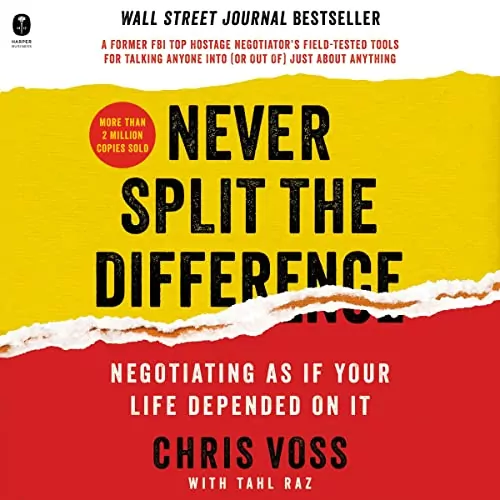“Never Split the Difference: Negotiating As If Your Life Depended On It” by Chris Voss, a former international hostage negotiator for the FBI, is a game-changing guide that sheds light on powerful negotiation tactics drawn from his high-stakes career.
Voss kicks off the book by debunking the myth that negotiation is a purely rational process. He asserts that negotiations are fundamentally emotional and are driven by human bias and irrationalities. Emotion, not rationality, is the driving force behind decision-making, so the first rule of negotiation, according to Voss, is to acknowledge the feelings of your negotiation partner.
The central part of the book consists of nine principles or techniques that Voss perfected throughout his career:
- The “Mirror Technique”: By repeating the last one to three keywords of your counterpart’s sentence, you show understanding and encourage them to keep talking and reveal more information.
- “Active Listening”: This technique involves using your counterpart’s name, making “I” statements, using open-ended questions, and summarizing their point of view to make them feel heard.
- “Tactical Empathy”: This concept suggests that you should understand and acknowledge your counterpart’s emotions and point of view to build rapport and trust.
- “Labeling”: This involves recognizing and voicing your counterpart’s emotions and fears to make them feel understood and disarm negative emotions.
- “Mastering No”: Instead of avoiding ‘no’, use it as a tool to protect your interests and keep negotiations open.
- “Creating the Illusion of Control”: By asking calibrated, open-ended questions, you can give your counterpart a sense of control, encouraging collaboration.
- “The 7-38-55 Percent Rule”: This rule implies that communication is only 7% verbal and 93% non-verbal (38% tone of voice and 55% body language), so paying attention to these factors is crucial.
- “Identify the Black Swan”: Black swans are unpredictable events with potentially severe consequences. In negotiation, black swans are pieces of information that can drastically change the outcome.
- “Bargain Hard”: This involves setting targets, using precise numbers, and offering a non-round number final offer, which can lead to better results.
Voss also debunks the idea that successful negotiation involves aiming for a win-win outcome. Instead, he advises to aim for a win for your side, as striving for mutual gains can often lead to splitting the difference, which might not always be beneficial.
Related: The 6 Types of Working Genius Summary
Throughout the book, Voss emphasizes that negotiation is a part of everyday life. Whether you’re buying a car, negotiating a salary, or simply deciding where to eat for dinner, these principles apply.
“Never Split the Difference” provides a captivating look into high-stakes negotiation, offering valuable tools not just for law enforcement, but for anyone wishing to improve their negotiation skills.
Book Club Questions
Here are some book club discussion questions for “Never Split the Difference: Negotiating As If Your Life Depended On It” by Chris Voss:
- How did Chris Voss’s background as an FBI hostage negotiator influence the approach to negotiation he presents in this book?
- How do the techniques presented in the book differ from traditional negotiation strategies you may have encountered?
- Can you think of a situation in your life where Voss’s tactics might have changed the outcome of a negotiation you were involved in?
- Discuss the role of emotions in negotiation as Voss presents it. How does this perspective challenge traditional views of negotiation?
- Which of the techniques discussed in the book do you find most effective or intriguing? Why?
- How does Voss’s book redefine the concept of a successful negotiation? Do you agree with his perspective?
- Discuss the ‘Black Swan’ concept. How does this concept apply to everyday negotiations outside of high-stakes situations like hostage negotiations?
- How does Voss suggest we handle hearing the word ‘no’? Can you think of a time when you could have applied this strategy?
- Voss argues that communication is 7% verbal and 93% non-verbal. How does this concept change the way you think about your own communication style?
- Do you believe the skills in this book are applicable to your everyday life? Can you give an example of how you might use one or more of these strategies in the future?
I hope you find Never Split the Difference summary helpful!






